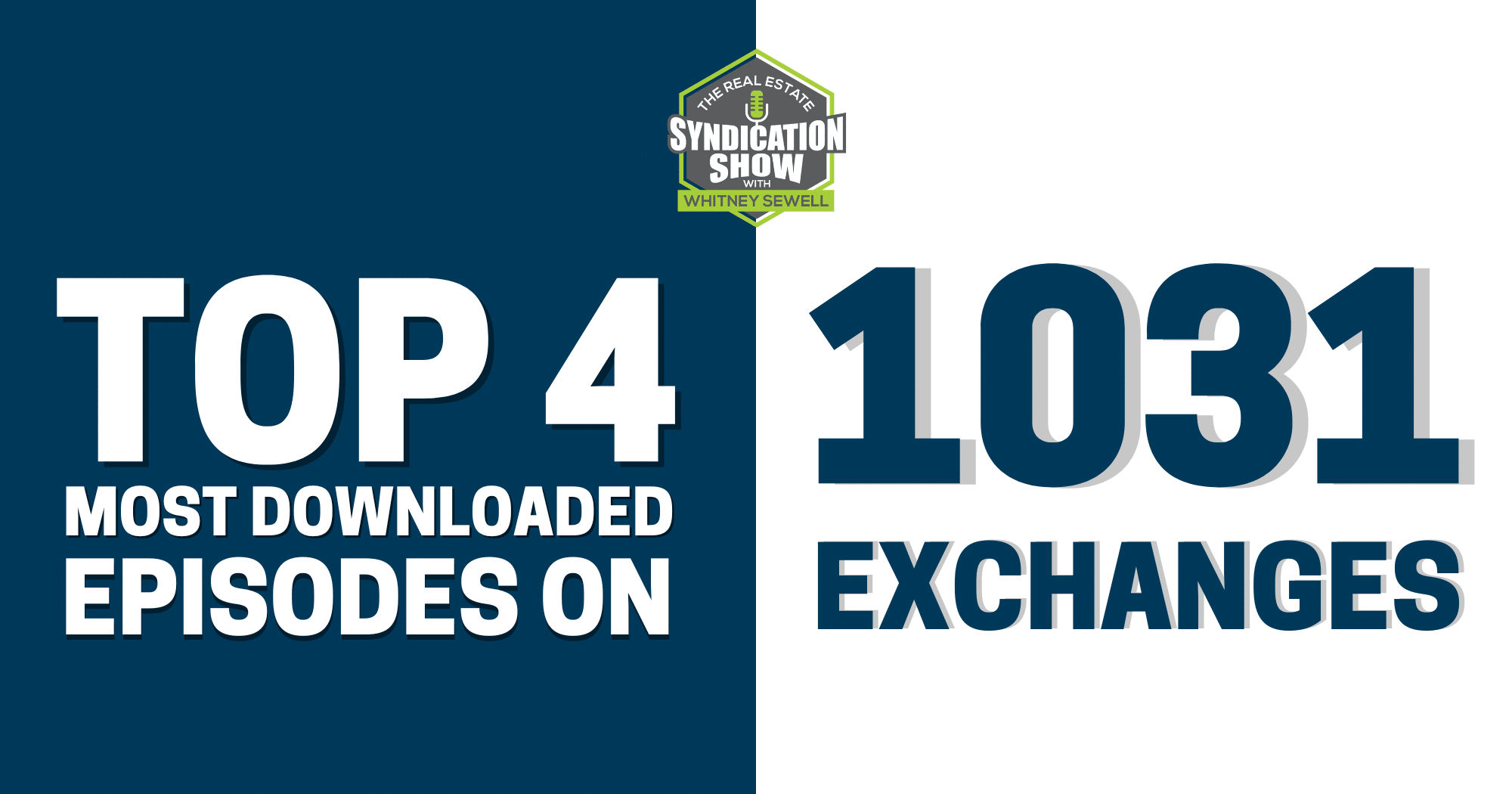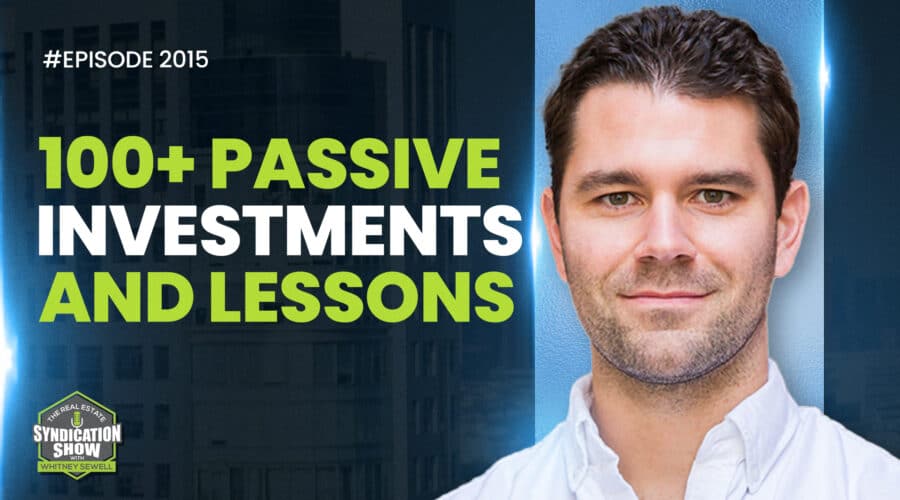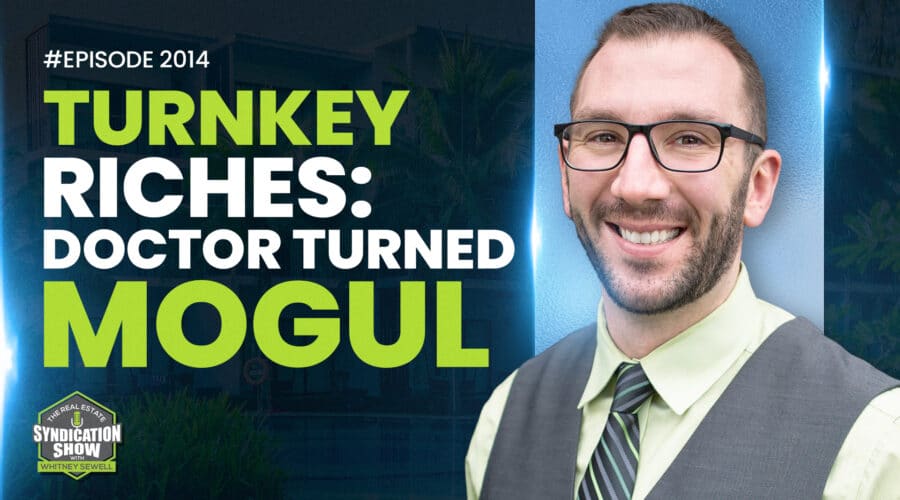In this episode, we look back at our conversations with Alex Shandrovsky & Michael Brady, Ted Lanzano, Sunil Chillar and Greg Lehrmann. Our discussion zeroes in on how these real estate investors leverage on 1031 Exchanges. Alex and Michael share their thoughts on entering a 1031 Exchange, while Ted explains what it is for a newbie investor.
Watch the episode here:
Listen to the podcast here:
Sunil, on the other hand, compares 1031 Exchange with a DST. Finally, Sunil tells us how the 1031 Exchange has come to be popular. Listen, learn and add these simple strategies to your passive investment plans!
Key Points From This Episode:
- How does a 1031 Exchange work?
- How can investors get into 1031 Exchange?
- What is the right use case for the 1031 Exchange versus the DST?
- What was Greg’s experience with 1031 Exchange back then?
Tweet This!
“I mean, it (1031) really is one of the available strategies when you sell an investment property. It’s one of the available strategies to defer the capital gains on the sale of a property. It’s probably in my mind, the most important wealth-building strategy in real estate investing.” – Ted Lanzano
“So you have to be able to have legal counsel or a title company or somebody who is going to actually do that deed that’s essentially it.” – Michael Brady
“If you have a 1031 that’s coming to that, whatever the reason, you weren’t able to buy a like-kind property, you could actually convert that into a DST.” – Sunil Chillar
“You have to have documents at the sale. And as long as you have that, now you have 45 days to identify a group of properties and we can get into the weeds on the different ways of doing that.” – Greg Lehrmann
Links Mentioned in Today’s Episode:
Alex Shandrovsky on LinkedIn
Michael S. Brady on LinkedIn
Ted Lanzaro
Sunil Chillar on LinkedIn
Greg Lehrmann on LinkedIn
WS466: Navigating a 1031 Exchange into a Syndication with Alex Shandrovsky & Michael Brady
WS1031: Taking Advantage of 1031 Exchanges | #Highlights
WS1319: DSTs and 1031 Exchanges | Sunil Chillar
WS817: The Secrets to 1031 Exchanges and The 1031 Outlook in 2021 with Greg Lehrmann
About Alex Shandrovsky
Alex Shandrovsky is a Silicon Valley seasoned entrepreneur. Starting with a $3,000 Loan, He built a multi-million dollar catering business serving leading tech companies including Google, Airbnb and Facebook. He has been featured in numerous publications including Haaretz, Newsweek and San Francisco Chronicle and has studied Digital Marketing at Dartmouth University Business School. As a Senior Business Development representative for Madison 1031 Exchange, Alex has the privilege of building multigenerational wealth for driven real estate investors. He is a proud husband and father to 3 adorable children.
About Michael Brady
Michael S. Brady is Executive Vice President of Madison 1031, a national Qualified Intermediary for tax-deferred Exchanges pursuant to Internal Revenue Code §1031. As a Certified Exchange Specialist® and attorney, his responsibilities include consulting with clients and their advisors to provide guidance on the regulations affecting §1031 Exchanges, as well as overseeing Madison 1031 Exchange’s national sales and marketing efforts. His seminars have received rave reviews for being both entertaining and informative, and his audiences have included top law and accounting firms as well as brokerage companies nationwide. Mr. Brady has published many articles on tax and legal issues and is the primary author behind the Madison 1031 Zone blog. Prior to joining Madison 1031, Mr. Brady headed up three other leading 1031 exchange companies, overseeing several thousand 1031 exchange transactions during his career. As an attorney, Mr. Brady has over 25 years of experience representing clients in commercial and residential real estate transactions, as well as a wide variety of business transactions and commercial litigation matters, and has acted as general counsel to a title insurance company.
About Ted Lanzaro
Ted Lanzaro is a Certified Public Accountant and real estate investor with over 29 years of real estate consulting and investing experience. He is also the author of The Tax-Smart Landlord, a book of tax strategies for real estate investors. Ted has helped thousands of investors nationally save millions of dollars in taxes in his career.
About Sunil Chillar
Sunil Chillar is the owner and broker of EXIT Realty Urban Living located in Downtown Jersey City. After receiving his bachelor’s degree in finance and economics from what is now known as New Jersey City University, he worked his way up to the Assistant Vice President position of a large American stock brokerage and asset management firm. Feeling unfulfilled in his career, Sunil decided to delve into the field of real estate. Since becoming a licensed agent in 2002, he has worked with property investors assisting them in purchases of over 5,500 units throughout the United States, he has managed over 100 units as a property manager, and has gained over 18 years of experience overseeing construction crews and renovation projects for his clients. Sunil specializes in short-sales, bankruptcy, and foreclosures, and has extensive experience handling multi-dwelling properties. His role in the office includes recruiting and training its agents, as well as overseeing the office’s operation.
About Greg Lehrmann
Greg Lehrmann, Esq., is a Division Manager/SVP with Asset Preservation, Inc. Asset Preservation, a subsidiary of Stewart Title Company, is a leading national IRC §1031 “Qualified Intermediary” and is efficiently handling exchanges in every state. Combining a national title company as a partner has proven to be the approach of choice by astute investors. Asset Preservation is one of the most respected national Qualified Intermediaries in the United States and has successfully completed over 180,000 §1031 exchanges throughout the nation. Mr. Lehrmann has 38 years’ experience in commercial and residential real estate law. He dedicates a significant portion of his time speaking to attorneys, CPAs, escrow officers, real estate agents/ brokers and investors on the many ways to improve investment returns through IRC Section 1031. His presentations feature many real-life exchange scenarios to illustrate a wide range of investment and tax strategies.
Full Transcript
EPISODE WS1635
[INTRODUCTION]
Whitney Sewell (WS): This is your Daily Real Estate Syndication Show. I’m your host, Whitney Sewell. Today, I hope you enjoy some of our most downloaded episodes on the 1031 Exchange.
[INTERVIEW 1]
WS: Our guests are Alex Shandrovsky and Michael Brady. You know, maybe, you all can get us started in that and let us walk through that process. Okay. I guess get us started in this process a little bit, I was just thinking about you know – if we have an investor that wants to 1031 into one of our syndications, what does that look like to make that actually happen and structure that, make sure we’re doing it legally and working with somebody like yourself?
Michael Brady (MB): Okay. Yeah, you know, structurally, you’ll have somebody who sold a piece of property, right? They’ve entered into a 1031 exchange, very critical that they do that before they close on their sale, they’ll have a qualified intermediary that’s been holding the money, right? They have 45 days from the close to identify their replacement property. You want to work with them very quickly to get them to identify your property. And specifically, they should identify the percentage interest, their buying in your project. You know, they’re buying 10% interest, they should say, “I’m buying 10% interest in 123 main street Dallas, Texas,” let’s say. That’s important.
And then, once they’re ready to close with you, it’s pretty much you know, it’s a little bit different, they’ll actually have to be a formal closing whereby you or you know, sometimes you just see these parties come in together with the syndicate to buy the property. But essentially, it’s deeded interest will go to that buyer. Door closing. We as the qualified intermediary take assignment of whatever agreement you have with them, the benefits of that and we fund the transaction. So, if we have a million dollars, we’ll spend a million dollars to whoever is handling the closing and the deed will go to the buyer directly. So you have to be able to have legal counsel or a title company or somebody who is going to actually do that deed that’s essentially it.
And certainly, the legal council should be involved in what we call tenant in common agreement between the parties.
Alex Shandrovsky (AS): So now I am going to jump the question to Mike because this is really fascinating. So, does a syndicator require agreement from the other investors to be able to bring in 1031 Exchange investors?
MB: Well that is a good question. It essentially depends on whatever that syndication agreement provides. So typically you know the limited partners in a syndicate don’t have much control over how things are structured and so you know the syndicators generally if the manager of the syndicate or the general partner even depending on what your structure is has the ability to make those decisions typically and there may be exceptions to that but typically they should be permitted to do that.
[INTERVIEW 2]
WS: Our guest is Ted Lanzaro. I know a lot of investors that are listening are wondering, how do we do this? What does that mean? Is this something I should do, this 1031 lingo that we hear all the time, right? Let’s get started as far as, maybe you give us just some brief background on what this is, and then let’s dive into some details.
Ted Lanzaro (TL): Okay. Yeah. Sounds good. I mean, it really is one of the available strategies when you sell an investment property. It’s one of the available strategies to defer the capital gains on the sale of a property. It’s probably in my mind, the most important wealth-building strategy in real estate investing. Here’s why, let me give you an example. I had a client who was a plumber, okay? As a plumber, he would go out and he would do his business, but he also started picking up small residential units, a two-family here, or four-family there, a small apartment building.
Over a period of about eight years, he built up a portfolio of about 150 units, right? That he was running and managing locally. Now, this was in South Florida and this was at a time when the market was beginning to rise. Prices were starting to go up. What he did was he actually sold his entire portfolio to another investor. He would have had about a million-dollar capital gain on the sale of all of those properties.
What he did was he decided, “Well, I’m going to do a 1031 Exchange.” He went and bought a shopping center on the main road in Boca Raton, Florida where I lived, and used that shopping center as his replacement property. He never paid tax on the million dollars. He just did this 1031 Exchange and bought a replacement property for actually more than what he sold the whole portfolio for.
Now over the next year and a half, he’s fixing up the shopping center and he’s putting new tenants into it, right? The markets continue to rise at this point also. At one point when it’s complete, he’s got it fully rented. He gets an offer for it, which is 2 million dollars more than he paid for, okay? Now he’s got basically a 3 million dollar capital gain. He’s like, “Well, what do I do now? I’m going to do another 1031 Exchange.”
He took the proceeds from the shopping center and he ended up investing them passively into six AutoZone buildings in Texas, which cost him a little bit more than what he had sold his shopping center for, but now he’s completely passive. It’s a triple net lease, so AutoZone is paying all the expenses on the buildings. He has a management company that basically collects the rent, writes the mortgage check, and sends them the balance. At that point, he’s making about $40,000 a month. Totally passive and now he’s retired, right?
He’s never paid the – he’s up now like 3 million dollars in capital gains and hasn’t been set in capital gains taxes, because he’s been using the 1031 Exchange to defer these capital gains. You can see how over the course of about five years, his net worth went up by 3 or 4 million dollars, but he never paid a dime in taxes. That’s why I say it’s a very important wealth-building strategy.
[INTERVIEW 3]
Sam Rust (SR): I’m your host, Sam Rust. This is your Daily Real Estate Syndication Show. Joining us today is Sunil Chillar, who is the owner and broker of Exit Realty Urban Living located in downtown Jersey City. You’ve done a lot of different things, but one question that I’ve had, I’d love to hear from you as an investor, kind of what you see as the right use case for the 1031 versus the DST. I think our audience has heard those terms, they’re probably very familiar with the 1031 exchange, essentially, you can defer taxes indefinitely if you can exchange lifetime property within certain windows, but maybe not as familiar with the DST, who should utilize which, and why, in your opinion.
Sunil Chillar (SC): It depends, right, circumstances. If you have a 1031 that’s coming to that, whatever the reason, you weren’t able to buy a like-kind property, you could actually convert that into a DST, number one. You could defer those taxes for 10 years and get an extension for an additional 10 years.
Not a lot of people know that. In addition to that, if you have a DST, let’s make the assumption that you sold a property and you made a million dollars, you only needed $200,000 out of that million dollars, you can actually withdraw that $200,000 without being penalized. Obviously, there’s more to it. But, I’m sorry, you’ll be taxed on the $200,000 not the $800,000. Another difference, money in a DST, you do not need to buy like-kind properties in addition to that, you don’t need to use the money just in real estate, you wanna divide crypto or by something else, go ahead and do so.
[INTERVIEW 4]
WS: Our guest is Greg Lehrmann. Are there some secrets that we need to think about right off the bat, that we need to know about 1031 Exchanges, that maybe there’s some myths or anything like that? What about the “exchange” word?
Greg Lehrmann (GL): Exchange doesn’t mean exchange. From 1921 to 1991, exchange meant exchange. They limited these to when like you and I trade. So, Whitney, if you wanted my property, the only way I could sell it to you without paying taxes is if it just so happens, you have something I want, or about the most creative thing that you could do before ’91, is I would find what I want and I would have to convince you to buy what I want. And then we would do a swap. So, exchange used to mean a direct swap. And in ’91, real estate investors went to Congress and said, “Look, that’s crazy to do it that way. Just let us do more like a roll over like a retirement account rollover.” That’s another way to simplify this. This is similar to a retirement account rollover, but you can do it at any age. And there’s no time when you have to start paying taxes as long as you’re in real estate.
So, they went to Congress, and they changed the law in ‘91. And they said, Congress said, “Okay, just sell to whoever wants your property so you can take as good of an offer, as you would have taken before. You’re not limiting your buyers to those that want to get involved with you, just sell, take your best offer, and as long as you have another company, hold your money between the sale and the purchase, we’re not going to tax you. And we’re going to give you 180 days between closing.” So, that’s how much they expanded it from having to do a direct simultaneous swap. But they also said you do have to identify the property within 45 days after you close.
So, the timeline is, first of all, you cannot do a 1031 if you don’t have documents at the closing of your sale, but that can be so easy if you deal with someone who only focuses on this. Since this is all we do. We have literally had people call us from the closing table that we’ve never heard of before. And they say they want to do a 1031, we need to have one conversation with them to make sure they understand all the fundamentals. We need the contract and the title work, and from that, we exchange documents and we email it to the closing. We’ve done that in less than an hour before. I don’t promote doing it that way, but you have to have documents at the sale. And as long as you have that, now you have 45 days to identify a group of properties and we can get into the weeds on the different ways of doing that. But the big picture is, you’ve got to put together a list of properties you’re considering within 45 days, and they give you a full 180 to close.
The 180 is almost never the challenge. The common challenge, as you know, I’m sure Whitney, is identifying within 45 days. So, when I first heard about 1031s, I got very excited. And then I found that you got to identify within 45 days, I got deflated. I thought, “Oh wow, that’s hard.” I figured out, “Look, the smart investors who learned about this, they don’t wait till they close their sale to tie up a property.” So, you have unlimited time between now and the closing of the sale, and then another 45 days to put your list together. And the main way that you can do it, there are other ways, but the three-property rule is the most common.
So, let’s say you just want one property, the three-property rule allows you to list three properties. And you can switch those out during the first 45 days, but not after that. But if you listed three properties, and you got past day 45, then your number one choice fell through at least you have two more on your list. But you can’t go grab another one somewhere else. But you can just go down your list and then close within 180. So, the exchange ever since ‘91 hasn’t really mapped the exchange the way you think of Whitney and I having to swap with each other. You just sell with the right kind of documents, you identify what you want to buy within 45 days and close within 180. And then the company that’s holding your funds, sends the money from your sale to the purchase. And it’s over with so many people say, “Oh, wow, I barely noticed anything was different.” So, that’s where the exchange is.
[END OF INTERVIEW]
[OUTRO]
WS: Thank you for being with us again today. I hope that you have learned a lot from the show. Don’t forget to like and subscribe. I hope you’re telling your friends about the Real Estate Syndication Show and how they can also build wealth in real estate. You can also go to LifeBridgeCapital.com and start investing today.
[END]
Love the show? Subscribe, rate, review, and share!
Join the Real Estate Syndication Show Community:









